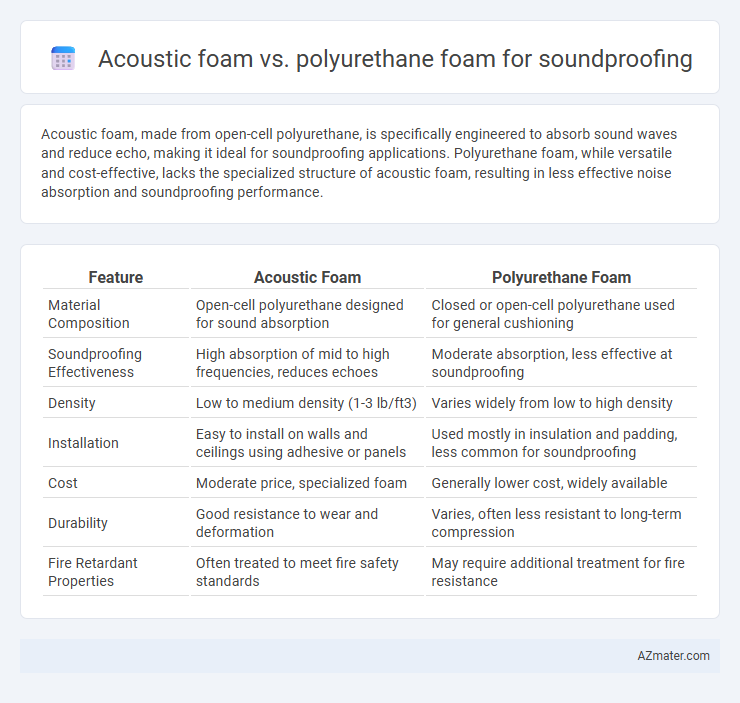Acoustic foam, made from open-cell polyurethane, is specifically engineered to absorb sound waves and reduce echo, making it ideal for soundproofing applications. Polyurethane foam, while versatile and cost-effective, lacks the specialized structure of acoustic foam, resulting in less effective noise absorption and soundproofing performance.
Table of Comparison
| Feature | Acoustic Foam | Polyurethane Foam |
|---|---|---|
| Material Composition | Open-cell polyurethane designed for sound absorption | Closed or open-cell polyurethane used for general cushioning |
| Soundproofing Effectiveness | High absorption of mid to high frequencies, reduces echoes | Moderate absorption, less effective at soundproofing |
| Density | Low to medium density (1-3 lb/ft3) | Varies widely from low to high density |
| Installation | Easy to install on walls and ceilings using adhesive or panels | Used mostly in insulation and padding, less common for soundproofing |
| Cost | Moderate price, specialized foam | Generally lower cost, widely available |
| Durability | Good resistance to wear and deformation | Varies, often less resistant to long-term compression |
| Fire Retardant Properties | Often treated to meet fire safety standards | May require additional treatment for fire resistance |
Introduction to Soundproofing Materials
Acoustic foam and polyurethane foam are widely used soundproofing materials designed to absorb and reduce noise levels in various environments. Acoustic foam features an open-cell structure optimized for sound absorption, effectively minimizing echo and reverberation in recording studios and home theaters. Polyurethane foam, often denser and more rigid, provides sound insulation by blocking sound transmission through walls and ceilings, making it suitable for industrial applications and building construction.
What is Acoustic Foam?
Acoustic foam is a specialized type of polyurethane foam designed to absorb sound waves, reducing echo and background noise within a space. It features an open-cell structure that dissipates sound energy by converting it into small amounts of heat, making it ideal for improving room acoustics without blocking sound transmission. Unlike standard polyurethane foam, acoustic foam is often shaped into wedges or pyramids to maximize surface area and enhance sound absorption efficiency.
What is Polyurethane Foam?
Polyurethane foam is a versatile synthetic material commonly used in soundproofing due to its excellent noise absorption properties and lightweight structure. Unlike acoustic foam, polyurethane foam can be manufactured with varying densities and firmness, allowing customization for different sound attenuation needs. Its open-cell structure effectively reduces airborne noise and reverberation, making it a popular choice in studios, theaters, and industrial applications.
Key Differences: Acoustic vs Polyurethane Foam
Acoustic foam is specifically engineered with an open-cell structure to absorb sound waves and reduce echo, making it ideal for soundproofing applications. Polyurethane foam, on the other hand, has a denser composition primarily designed for insulation and cushioning but lacks the tailored acoustic properties for effective noise control. Key differences include acoustic foam's superior sound absorption coefficients and fire retardant qualities, whereas polyurethane foam typically offers lower sound absorption and may pose greater flammability risks.
Sound Absorption Capabilities Compared
Acoustic foam, specifically designed for sound absorption, features an open-cell structure that effectively traps and dissipates sound waves, reducing echo and reverberation in rooms. Polyurethane foam, while cheaper and denser, offers moderate sound absorption but lacks the specialized surface patterns and porosity needed for high-frequency sound attenuation. Overall, acoustic foam outperforms polyurethane foam in sound absorption capabilities due to its tailored materials and design optimized for noise control.
Effectiveness in Noise Reduction
Acoustic foam is specifically designed with open-cell structures to absorb mid to high-frequency sound waves, making it highly effective for reducing echoes and reverberation in indoor environments. Polyurethane foam, while commonly used for general cushioning, lacks the precise acoustic engineering needed for significant noise reduction and primarily dampens only limited frequencies. For targeted soundproofing, acoustic foam provides superior noise absorption and improves overall sound clarity compared to standard polyurethane foam.
Durability and Longevity
Acoustic foam, typically made from melamine or open-cell polyurethane, offers superior durability and maintains its shape and sound absorption properties longer than standard polyurethane foam, which tends to degrade and compress over time. Polyurethane foam used for soundproofing often breaks down faster due to its softer structure, leading to diminished acoustic performance and a shorter lifespan. For long-term soundproofing solutions, acoustic foam provides enhanced longevity, resisting wear, moisture, and environmental factors better than conventional polyurethane foam.
Cost and Budget Considerations
Acoustic foam typically costs more than polyurethane foam due to its specialized design for sound absorption and noise reduction, making it a preferred choice for high-performance soundproofing. Polyurethane foam offers a budget-friendly alternative, often used in less demanding environments, but it provides lower sound attenuation and durability. When balancing cost and effectiveness, acoustic foam delivers superior long-term value despite the higher initial investment, whereas polyurethane foam suits projects with strict budget constraints but modest acoustic needs.
Installation and Maintenance
Acoustic foam typically offers easier installation due to its lightweight, peel-and-stick design that adheres directly to walls and ceilings, making it ideal for quick soundproofing setups. Polyurethane foam, while effective in noise absorption, often requires professional installation because of its denser structure and potential need for adhesives or framing. Maintenance for acoustic foam is generally low, involving simple dusting or vacuuming, whereas polyurethane foam may demand more attention to prevent degradation or moisture damage in humid environments.
Best Applications for Each Foam Type
Acoustic foam excels in reducing echo and improving sound clarity in recording studios, home theaters, and vocal booths due to its open-cell structure that absorbs mid to high-frequency sound waves. Polyurethane foam, with its denser composition, is better suited for thermal insulation and general noise reduction in industrial settings and HVAC systems where it can also dampen low-frequency sounds. Selecting the appropriate foam depends on whether the primary goal is sound absorption for audio quality enhancement or broader noise and thermal insulation needs.

Infographic: Acoustic foam vs Polyurethane foam for Soundproofing
 azmater.com
azmater.com